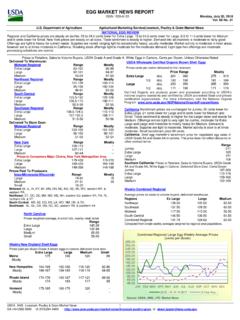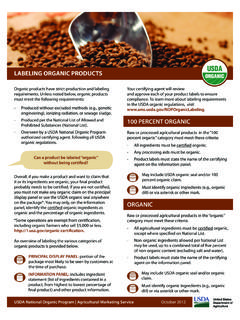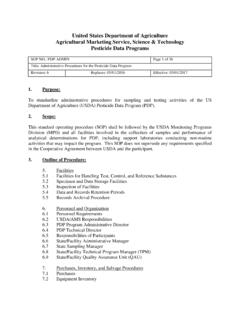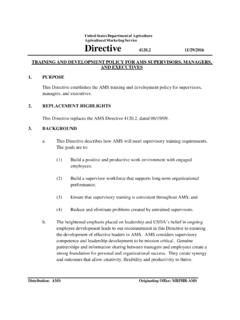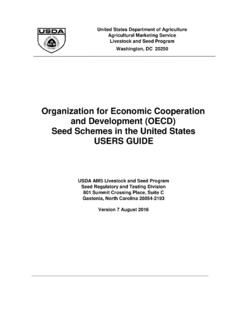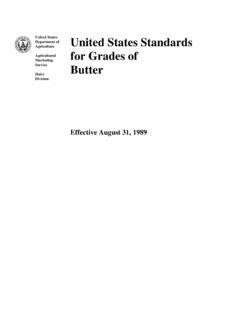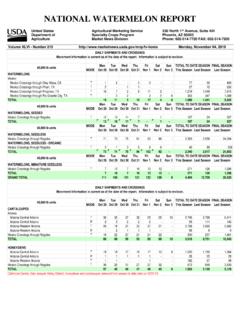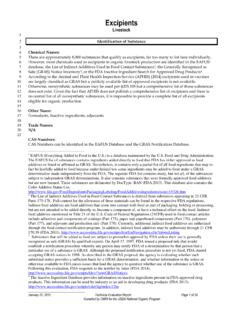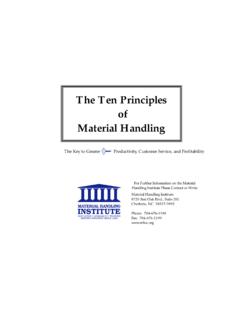Transcription of Guidance Commingling and Contamination Prevention in ...
1 United States Department of Agriculture 1400 Independence Avenue SW. NOP 5025. Agricultural Marketing Service Room 2646-South Building Effective Date: July 22, 2011. National Organic Program Washington, DC 20250 Page 1 of 4. Guidance Commingling and Contamination Prevention in Organic Production and handling 1. Purpose This Guidance document reiterates the importance of the management practices and physical barriers that need to be clearly described in an organic system plan (OSP) and implemented to prevent loss of organic integrity through Commingling or Contamination of organic products with nonorganic products or prohibited substances. 2. Scope This Guidance applies to all accredited certifying agents and certified and exempt operations. 3. Background The National Organic Program (NOP) regulation at requires that the OSP describe the management practices and physical barriers employed to prevent Commingling of organic and nonorganic products on an organic or a split operation ( those operations that produce or handle both organic and non-organic agricultural products).
2 Protective practices to prevent organic products from contacting prohibited substances that could compromise the integrity of the organic products are required under The regulations do not require a specific section in the OSP for this item. 4. Policy General All organic or split production or handling operations must clearly describe their specific management practices that prevent Commingling or Contamination in their OSP. All certifying agents are responsible for verifying that certified operations have sufficient management practices in place to prevent the Commingling and Contamination of organic products with nonorganic products and prohibited substances. The OSP should specifically address the operation's organic control points and the preventative measures employed to avoid the loss of organic integrity. The organic control points are the points where Contamination and Commingling could occur resulting in a loss of organic integrity.
3 Depending on the type of operation, examples of organic control points can include organic and adjoining non-organic areas, receiving and storage areas for inputs and ingredients, processing equipment used for organic and non-organic products, adjacent lands and their associated land management practices ( , pesticide applications or use of genetically modified crops), and receiving areas for feed and inputs such as soil amendments. Certifying agents can consider including an additional section in the OSP that allows producers and handlers to summarize their risks, or their organic control points, and the risk Prevention and avoidance measures implemented throughout their operation. This can include checklists and narrative questions that assist the producer or handler in describing their unique Contamination risks, explaining their Original Issue Date: 05/09/11 Authorized Distribution: Public File Name: NOP 5025 Commingling & Contamination Rev01 07 22 11.
4 United States Department of Agriculture 1400 Independence Avenue SW. NOP 5025. Agricultural Marketing Service Room 2646-South Building Effective Date: July 22, 2011. National Organic Program Washington, DC 20250 Page 2 of 4. Prevention practices, and documenting their efforts. During inspection, certifying agents should assess the risks, and verify the adequacy and actual implementation of the described practices and procedures to ensure that preventive Commingling and Contamination activities are carried out and consistently documented. Preventive practices may include physical boundaries, buffer zones, separate receiving, and manufacturing areas for organic products, clean-out procedures, training of organic and non-organic personnel, or completely separate and different storage, packaging or packaging transportation systems.
5 Evaluation of records and on-site inspections may also include the review of non-organic activities and areas of the certified operation to verify compliance with the Commingling and Contamination Prevention provisions of the NOP. regulations. Organic Control Points Production and handling operations need to identify and address their Commingling and Contamination risks, or organic control points, in their OSP. This applies to both all organic and split operations. 1. Examples of common organic control points for production or handling operations can include, but are not limited to: a. Sanitation and pest management materials and practices;. b. Organic and adjoining non-organic areas;. c. Reuse of boxes and transportation containers;. d. Adequacy of equipment and storage unit cleaning and purging;. e. Receiving inputs and ingredients.
6 F. Storage and identification of prohibited substances, such as pesticides, fertilizers, feeds, feed supplements, and health care inputs;. g. Use of custom operators and their equipment;. h. Transportation unit clean-out, documentation and inspection; and i. Use of outside trucking services for the handling and transportation of organic product to market. 2. Examples of organic control points for crop and pasture operations can include, but are not limited to: a. Environmental conditions, such as the prevailing winds, land slope, upstream uses of creeks and waterways, and their impact on the adequacy of buffer zones between organic and adjoining non-organic areas;. b. Types of crops grown nearby ( genetically modified crops);. c. Pest management materials used on non-organic farms nearby and how materials are applied ( backpack, airplane, fumigation, spray).
7 D. Pest and weed management of adjoining public roads and areas; and e. Any other potential point or non-point sources of Contamination . 3. Examples of organic control points for livestock operations can include, but are not limited to: a. Management of any livestock treated with prohibited substances;. b. Origin and verification of compliance of new animals; and c. Verification and compliance of off-farm sources of feed, such as bales of hay and bins of grain. Original Issue Date: 05/09/11 Authorized Distribution: Public File Name: NOP 5025 Commingling & Contamination Rev01 07 22 11. United States Department of Agriculture 1400 Independence Avenue SW. NOP 5025. Agricultural Marketing Service Room 2646-South Building Effective Date: July 22, 2011. National Organic Program Washington, DC 20250 Page 3 of 4. 4. Production and handling operations need to have procedures to address organic control points in their OSP.
8 Procedures can include, but are not limited to: a. Preventive measures for each Contamination or Commingling risk, or organic control point;. b. Procedures to monitor the organic control point;. c. Corrective actions for all organic control points or products which have lost organic integrity;. and d. Effective record-keeping that documents each step of the production and handling system. 5. Certifying agents must verify that: a. All Contamination and Commingling risks are sufficiently identified and addressed in the OSP. b. The practices and procedures to prevent Contamination and Commingling are well-described, implemented, and monitored with appropriate record-keeping and documentation, and comply with the NOP regulations. 5. References Terms Defined Commingling . Physical contact between unpackaged organically produced and nonorganically produced agricultural products during production, processing, transportation, storage or handling , other than during the manufacture of a multi-ingredient product containing both types of ingredients.
9 Organic system plan. A plan of management of an organic production or handling operation that has been agreed to by the producer or handler and the certifying agent and that includes written plans concerning all aspects of agricultural production or handling described in the Act and the regulations in subpart C of this part. Practice standard. The guidelines and requirements through which a production or handling operation implements a required component of its production or handling organic system plan. A practice standard includes a series of allowed and prohibited actions, materials, and conditions to establish a minimum level performance for planning, conducting, and maintaining a function such as livestock health care or facility pest management, essential to an organic operation. Prohibited substance. A substance, the use of which in any aspect of organic production or handling is prohibited or not provided for in the Act or the regulations of this part.
10 Split operation. An operation that produces or handles both organic and nonorganic agricultural products. Other Definitions Organic Integrity. The quality of an organic product or system which is achieved through verified adherence to organic standards from farm production through all points of handling and processing to the point of final sale to the consumer. Original Issue Date: 05/09/11 Authorized Distribution: Public File Name: NOP 5025 Commingling & Contamination Rev01 07 22 11. United States Department of Agriculture 1400 Independence Avenue SW. NOP 5025. Agricultural Marketing Service Room 2646-South Building Effective Date: July 22, 2011. National Organic Program Washington, DC 20250 Page 4 of 4. Organic Control Point. Any point or procedure in an organic production or handling system where loss of organic integrity may occur through Commingling with non-organic product or Contamination with prohibited substances.
